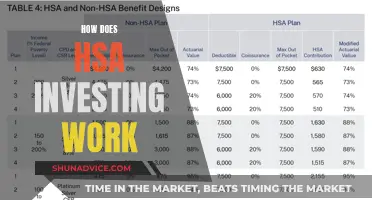
The Rule of 72 is a quick and easy formula that can be used to estimate how long it will take for an investment to double at a given annual rate of return. It is calculated by dividing 72 by the expected annual rate of return, giving the number of years it will take for the initial investment to double. For example, if an investment scheme promises an 8% annual compounded rate of return, it will take approximately nine years (72 / 8 = 9) to double the money. The Rule of 72 is a useful shortcut for investors to determine how their investments will grow over time and is most accurate for rates of return between 6% and 10%.
| Characteristics | Values |
|---|---|
| Rule of | 72 |
| Annual Rate of Return | 36% |
| Years to Double Investment | 2 |
What You'll Learn
- The Rule of 72: a formula to estimate how long it takes for an investment to double
- How to calculate the time it takes for an investment to double using the Rule of 72?
- How to calculate the interest rate needed to double an investment in a certain time?
- How the Rule of 72 can be used to reverse engineer investment goals?
- The accuracy of the Rule of 72

The Rule of 72: a formula to estimate how long it takes for an investment to double
The Rule of 72 is a formula used to estimate how long an investment will take to double at a given rate of return. It is calculated by dividing 72 by the annual rate of return, giving a rough estimate of how many years it will take for the initial investment to duplicate itself.
For example, if you invest at a fixed annual interest rate of 10%, it will take 7.2 years for your investment to double (72 divided by 10 equals 7.2). In reality, an investment with a 10% rate of return will take 7.3 years to double. The Rule of 72 is reasonably accurate for low rates of return, but less so as rates increase.
The Rule of 72 is a simplified formula that is useful for quick mental calculations. It is often taught to beginner investors as it is easy to understand and calculate. It is also useful when only a basic calculator is available. The formula is more accurate for rates of return between 5% and 10%.
The Rule of 72 can also be used to estimate the rate of return needed for an investment to double within a certain time frame. For example, if you want to double an investment in 5 years, divide 72 by 5, which indicates that you will need to earn 14.4% interest annually (72 divided by 5 equals 14.4).
The Rule of 72 is a shortcut calculation for situations involving compound interest. It does not work well with simple interest rates. The formula can be adjusted for higher accuracy, particularly for continuous compounding interest rates, where the Rule of 69.3 is considered more accurate.
FTX: How Investors Got Duped
You may want to see also

How to calculate the time it takes for an investment to double using the Rule of 72
The Rule of 72 is a formula that estimates how long an investment will take to double in value, earning a fixed annual rate of return. It's a quick and simple calculation that can be done without a calculator, making it a handy rule of thumb for investors.
Here's how it works:
To calculate the number of years it will take for an investment to double, divide 72 by the expected annual rate of return. For example, if an investment scheme promises an 8% annual compounded rate of return, it will take approximately nine years (72 / 8 = 9) for the initial investment to double.
The Rule of 72 is most accurate for rates of return between 5% and 10%. For rates outside this range, the formula can be adjusted by adding or subtracting 1 from 72 for every 3 percentage points the interest rate diverges from 8%. For example, for a 14% rate of return, you would use the Rule of 74 (72 + (2 x 3) = 74) for greater precision.
It's important to note that the Rule of 72 is not exact and provides a rough estimate. For more precise calculations, the Rule of 69.3 or the full compound interest formula can be used.
Additionally, the Rule of 72 assumes that the rate of return remains constant over the investment period. If the rate of return is expected to change, the formula may not provide an accurate estimate.
The Rule of 72 can also be used to estimate how long it will take for the effects of inflation to halve the value of money. For example, with an inflation rate of 6%, it would take approximately 12 years for the purchasing power of a given sum of money to be halved (72 / 6 = 12).
In summary, the Rule of 72 is a useful tool for investors to quickly estimate how long it will take for their investments to double in value or how inflation will impact their money's buying power over time.
Calculating Investment Returns: A Comprehensive Guide
You may want to see also

How to calculate the interest rate needed to double an investment in a certain time
The Rule of 72 is a formula used to estimate the number of years required for an investment to double, given a fixed annual rate of return. It can also be used to calculate the annual rate of compounded return from an investment, given the number of years it will take to double.
Here's how to calculate the interest rate needed to double an investment in a certain time:
Firstly, it's important to note that the Rule of 72 is a simplified formula for estimating compound interest calculations. It assumes that the frequency of compounding is once per period and that accrued interest is compounded over time.
The formula for the Rule of 72 is:
> R = interest rate per period as a percentage
>
> t = number of periods
In most cases, the interest rate is annual, and the time period is in years.
To calculate the interest rate required to double your investment within a known time frame, use the following formula:
> R = 72 / t
For example, if you want to double your investment in 5 years, you would divide 72 by 5, which equals 14.4. This means you would need to earn 14.4% interest annually for 5 years to double your investment.
The Rule of 72 is most accurate for interest rates ranging from 6% to 10%. For higher accuracy, you can adjust the formula to the Rule of 69.3 or use other rules like the Rule of 70 or Rule of 73.
Fidelity Investments: Unlocking Dividend Potential
You may want to see also

How the Rule of 72 can be used to reverse engineer investment goals
The Rule of 72 is a simple formula that can be used to estimate how long an investment will take to double, given a fixed annual rate of interest. It can also be used to estimate the rate of return needed for an investment to double given a specific investment period.
To calculate the time period an investment will take to double, divide 72 by the expected rate of return. For example, if an investment scheme promises an 8% annual compounded rate of return, it will take approximately nine years (72 / 8 = 9) to double the invested money.
The Rule of 72 can be used to reverse engineer investment goals by helping investors determine how much they need to invest to reach a certain amount by a specific date. For example, if you know you need to have a certain amount of money saved for retirement, the Rule of 72 can give you a general idea of which asset classes you'll need to invest in to achieve your goal.
The Rule of 72 can also be used to estimate the rate of return needed to double an investment within a certain time frame. For example, if you want to double an investment in 5 years, divide 72 by 5 to determine that you'll need to earn 14.4% interest annually on your investment (14.4 x 5 = 72).
Additionally, the Rule of 72 can be used to estimate how long it will take for an investment to reach a certain value. For example, if you have $1,000 to invest and want to put it all in stocks, you can use the Rule of 72 to estimate how long it will take to reach $2,000, $4,000, or $6,000.
While the Rule of 72 is a useful guideline, it is important to note that it only provides a framework and does not take into account investment fees or taxes. For more precise outcomes, investors can use the Rule of 69.3 or consult a professional financial advisor.
Retirement Investing: Navigating Your Superannuation Options
You may want to see also

The accuracy of the Rule of 72
The Rule of 72 is a simple formula that estimates how long an investment will take to double at a given return rate. It is calculated by dividing 72 by the annual compound interest rate.
The Rule of 72 is not entirely accurate, but it is a quick way to get a useful ballpark figure. It is most accurate for rates of return of about 5% to 10%, with 8% being the most accurate. For rates outside of this range, the rule becomes too imprecise to be trusted. For higher precision, slight adjustments can be made depending on the specific interest rate, such as using 69 or 70 for very high or low rates. For example, for every three points that an interest rate deviates from 8%, you can adjust the number 72 by one in the direction of the rate change. So, if the rate is 5%, you would use 71, and if it is 11%, you would use 73.
The Rule of 72 is particularly useful for interest rates between 6% and 10%, offering a quick mental calculation for investors and financial planners. It is also valuable for a variety of financial scenarios, such as estimating the growth of stocks, bonds, or savings accounts, and understanding the impact of inflation and compounding interest on debt.
While the Rule of 72 is a helpful shortcut, it is important to note that it is not a substitute for a true compound interest calculation. For more precise outcomes, the Rule of 69.3 can be used, which involves dividing 69.3 by the rate of return. This rule is preferred by many investors and is more accurate, especially for continuous compounding interest rate instruments.
Retirement Investment Strategies: Should You Stay or Should You Go?
You may want to see also
Frequently asked questions
Your investment will double in two years. This is calculated by dividing 72 by the interest rate of 36%.
The Rule of 72 is a formula used to estimate how long an investment will take to double based on a fixed annual rate of interest. You divide 72 by the annual rate of return to get the approximate number of years it will take for your initial investment to double.
Compound interest is calculated on both the initial principal and the accumulated interest from previous periods of a deposit. Simple interest, on the other hand, is determined by multiplying the daily interest rate by the principal amount and the number of days between payments.
Yes, there are other rules such as the Rule of 69, Rule of 70, and Rule of 73 that can be used in different situations. Additionally, you can use online compound interest calculators to get more precise estimates.







